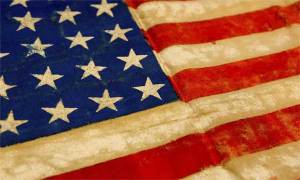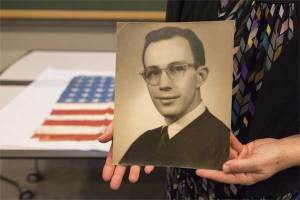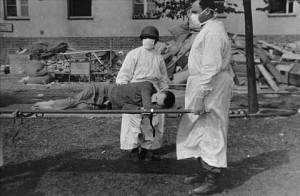Holocaust survivors thanked GI with American flag

Kyra Schuster, a curator at the United States Holocaust Memorial Museum in Washington, D.C., recently took part in a once-in-a-lifetime experience when the family of Sgt. Donald Hall donated an American flag. It was given to the WWII soldier 70 years ago by survivors of Langenstein, a Nazi concentration camp. Schuster agreed to answer some questions about the handmade banner.
Q: How did you find out about the flag, and what was your initial reaction to its existence?

A: I received a phone call from one of Donald Hall’s daughters. I wasn’t surprised to hear that she was calling about a flag that her father brought home from WWII, as we receive a large number calls about Nazi flags brought home as war souvenirs by GIs. What did surprise me was that it was an American flag and the story behind it. We have heard of similar flags, which were made by prisoners for the liberators, but we didn’t have any in our collection.

Q: What’s the story of the making of the flag?
A: Unfortunately, we don’t know who made the flag. I presume it was made closer to the time Langenstein was liberated [in 1945]. It appears to have been painted (rather than sewn). I’m hoping our textile conservator will be able to provide some additional information about the materials.

Q: Why was it given to Sgt. Hall and not someone else?
A: From what the family told me, Hall may not have been the first GI in the unit to receive the flag. It’s possible it was passed on to him by another member of his unit. He didn’t discuss the finer details of his experiences during the liberation of Langenstein with his family. We see this quite often with survivors and veterans who find it difficult to discuss what they experienced.

Q: Will the flag be displayed publicly?
A: There are no [current] plans to display the flag. It will be cataloged. Once that is completed, the record will be accessible on the Museum’s online catalog. At some point, [it could be] placed in our permanent exhibition. Hopefully, someone will hear the story of Donald Hall’s flag and help fill in the gaps – whether that be a survivor or relative of a survivor who helped make the flag, or a fellow member of the 83rd Infantry Division.
Q: What other WWII-era flags does the museum hold?
A: We have a number of different types of Nazi flags, which GIs brought home as war souvenirs. Some are signed by the liberating units, and their sizes range from huge banners which hung on the sides of buildings to small flags attached to automobiles. We also have flags from other countries and flags representing each of the U.S. Army liberating units. Some of the more unique ones include Boy Scout troop flags from Jewish refugees in Shanghai, China; flags from the Cyprus detention camps; and a handmade Israeli flag created by a Polish Jewish girl in a displaced persons camp in Austria to celebrate Israeli statehood.
(Ms. Schuster added that “we are always looking to add to our holdings, so if someone [has] a flag or other items they would like to offer to the Museum, they can contact us through our webpage: http://www.ushmm.org/research/research-in-collections.” To view a C-SPAN broadcast about the flag, go to http://www.c-span.org/video/?327538-1/discussion-langenstein-concentration-camp-83rd-infantry.)
